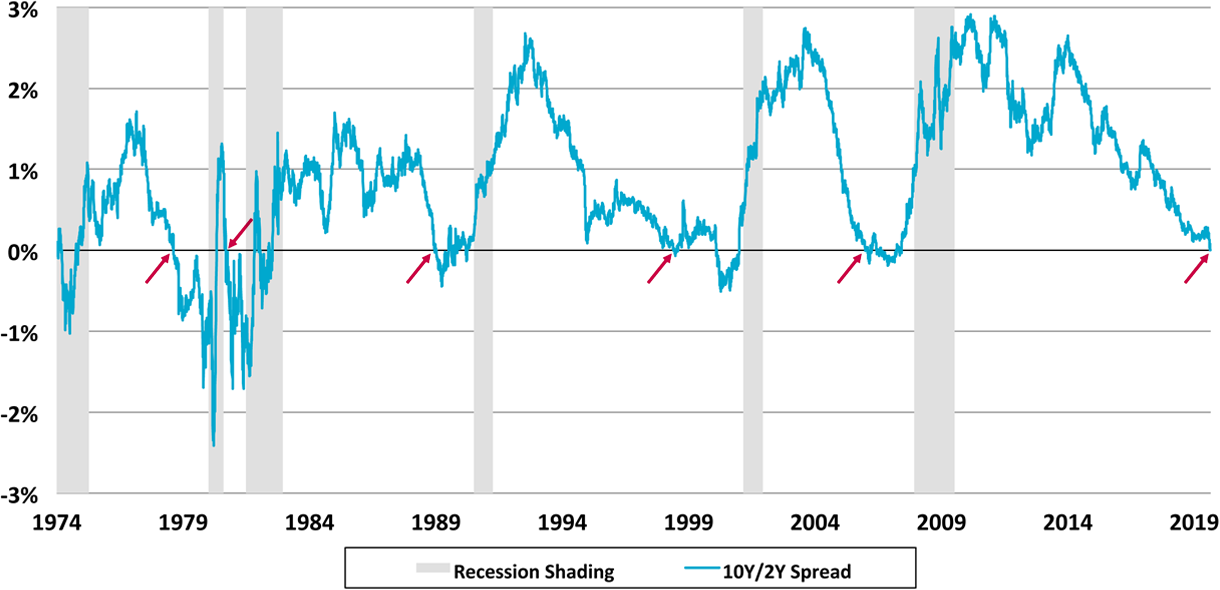Joe Zidle: This Time Isn’t Different
Legendary investor Sir John Templeton said that the four most expensive words in investing are “This time it’s different.” The most predictive part of the Treasury yield curve, the 10-year to 2-year spread, has inverted during intraday trading in five of the last nine trading days. Yesterday, this spread inverted on a closing basis. This indicates that the US economic expansion may have between 1-2 years before falling into recession. Get ready to hear justifications for why the yield curve signal shouldn’t be trusted this time. Ignore them. I subscribe to Templeton’s words, and urge our readers to do the same.
10Y/2Y Spread Inverted Before Each of the Last Five Recessions (1)

The tech bubble
In the late 1990s, tech stocks boomed and the economy ripped. The Dot Coms infatuated investors. Some even believed the Internet made economic cycles things of the past. Starting in February 1995, the Dow rallied 94% for over two years without a single 10% drawdown.(2) When the yield curve inverted in May 1998, the market did enter a brief bear market, but it lasted less than two months.(3) Investors convinced themselves that the yield curve was obsolete. Subsequently, the stock market began one of the greatest rallies ever; the Dow gained 59% and the Nasdaq jumped an unbelievable 257%.(4) It didn’t last. The Nasdaq plunged nearly 78% from 2000 to 2002 as the economy fell into recession.
The housing bubble
In 2007, that pernicious argument—This time it’s different—reared its ugly head again. That bubble was in the housing markets. Nationally, housing prices were up 14% in the 12 months before the yield curve inverted and up a cumulative 55% over the prior four years.(5) The curve inverted, but investors argued that quirks in the debt structure rendered the recession signal outdated, i.e., it was a technical inversion, not a fundamental one. They said that housing prices never went down and that the economy was fine. Not quite. The Great Financial crisis emerged shortly thereafter.
Excess liquidity, excess speculation
Excess characterizes the end of an economic cycle. Sometimes it can be in the real economy, in sectors like housing. Other times it’s in the financial markets, in sectors like tech. As we recently discussed, now it’s in bond markets all around the world. Globally, more than $16 trillion of bonds trade at negative yields, representing nearly half of the global investment grade bond universe, ex-US.(6) There is a glut of liquidity, and this money is looking for a place to hide. As a result, investors have to pay banks and even companies to hold their cash. Sovereign bonds and traditional, taxable fixed income have joined the list of other bubbles. And the yield curve is telling us that it will pop soon.
Precedent bests psychology
After the first intraday inversion on August 14th, we got a preview of the arguments that would be used to explain away the yield curve’s signal: a deeply negative term structure, central bank balance sheets, deflation, demographics, etc. History shows that investors will likely be convinced by at least one of these assertions. Equities will continue to move higher, the curve will probably revert and data will improve. These are especially likely if we get a temporary reprieve from trade tensions. But the curve has inverted five times since the late 1970s—and each time a recession started an average of 20 months later. Make no mistake, a recession will eventually come. And Templeton’s counsel will be as true as it ever was.



